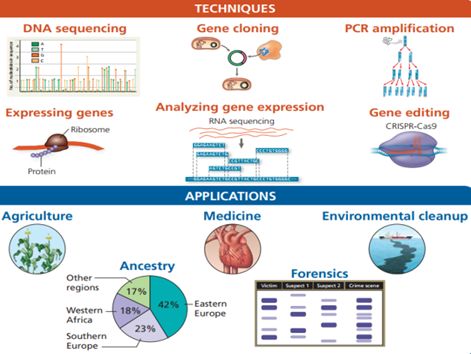Microorganisms, Medicines, and Bioremediation.

Since the discovery of penicillin in the 1920s, biotechnology has played a key role in the development of medicines.
Producing penicillin
The first effective antibiotic was penicillin, produced by a mould called Penicillium notatum.
The yield of penicillin from this mould was very small.
Commercial production of the drug in the quantities needed to treat everyone who needed it did not begin until the discovery of Penicillium chrysogenum by Mary Hunt on a melon from a market stall.
-
P. chrysogenum needs relatively high oxygen levels and a rich nutrient medium to grow well.
It is sensitive to pH and temperature.
This affects the way it is produced commercially.
A semi-continuous batch process is used to culture microorganisms on an industrial scale.
- In the first stage of the production process, the fungus grows.
- In the second stage, it produces penicillin.
- Finally, the drug is extracted from the medium and purified.
The process uses relatively small fermenters (40-200dm3) because it is very difficult to maintain high levels of oxygenation in very large bioreactors.
The mixture is continuously stirred to keep it oxygenated.
There is a rich nutrient medium.
The growth medium contains a buffer to maintain pH at around 6.5.
The bioreactors are maintained at about 25-27 °C.
Making insulin
Biotechnology in the form of genetic engineering is important in the production of human medicines.
For example, the production of human insulin.
People with type 1 diabetes, and some people with type 2 diabetes, need regular injections of insulin to control their blood sugar levels.
In the past, insulin was extracted from the pancreas of animals, usually pigs or cattle, slaughtered for meat.
This meant the supply was erratic because it depended on the demand for meat when fewer animals were killed, less insulin was available but the number of people with diabetes stayed the same.
There were a number of other problems.
Some people were allergic to animal insulin as it was often impure, although eventually very pure forms were developed which overcame this problem.
The peak activity of animal insulin is several hours after it is injected, which makes calculating when to eat meals difficult.
For some faith groups, using pig products is not permitted.
The development of genetically engineered bacteria which can make human insulin revolutionized the supply from the 1970s onwards.
The bacteria are grown in a fermenter and downstream processing results in a constant supply of pure human insulin.

Bioremediation
In bioremediation, microorganisms are used to break down pollutants and contaminants in the soil or water.
There are different approaches to bioremediation:
-
Using natural organisms
Many microorganisms naturally break down organic material producing carbon dioxide and water.
Soil and water pollutants are often biological, for example, sewage and crude oil.
If these naturally occurring microorganisms are supported, they will break down and neutralize many contaminants.
For example, in an oil spill, nutrients can be added to the water to encourage microbial growth, and the oil can be dispersed into smaller particles to give the maximum surface area for microbial action.
-
GM organisms
Scientists are trying to develop GM bacteria that can break down or accumulate contaminants which they would not naturally encounter
For example, bacteria have been engineered that remove mercury contamination from water.
Mercury is very toxic and accumulates in food chains.
The aim is to develop filters containing these bacteria to remove mercury from contaminated sites.
Often, bioremediation takes place on the site of the contamination.
Sometimes material is removed for decontamination.
In most cases, natural microorganisms outperform GM ones but as our ability to change the genetic material of microorganisms increases, it may be possible to use bioremediation even more effectively than it is used now.
Plants and bioremediation
There are some pollutants which microorganisms cannot, at the moment, remove from the soil.
In many cases, special plants can be used instead.
In the early 1920s, a tree was discovered that produced a blue sap that turned out to contain 26% nickel in its dry mass.
Plants which can take up large quantities of metals from the ground are known as hyperaccumulators.
The process by which hyperaccumulators take up metals from the ground is known as bioleaching.






